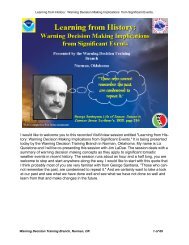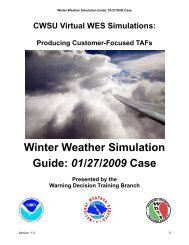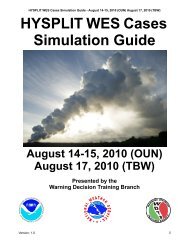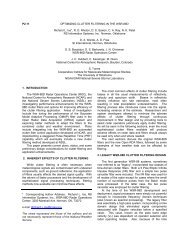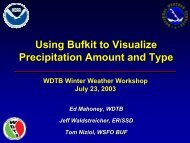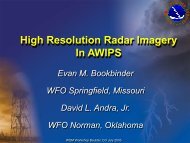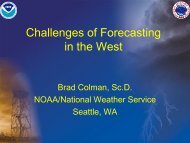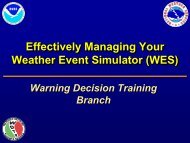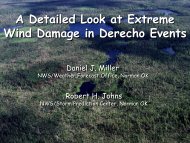Concept of Operations for the Enhanced VCP 121 to Mitigate Range ...
Concept of Operations for the Enhanced VCP 121 to Mitigate Range ...
Concept of Operations for the Enhanced VCP 121 to Mitigate Range ...
You also want an ePaper? Increase the reach of your titles
YUMPU automatically turns print PDFs into web optimized ePapers that Google loves.
<strong>Concept</strong> <strong>of</strong> <strong>Operations</strong> <strong>for</strong> <strong>the</strong><strong>Enhanced</strong> <strong>VCP</strong> <strong>121</strong> <strong>to</strong> <strong>Mitigate</strong> <strong>Range</strong> AliasingW. David ZittelROC Applications Branch1. IntroductionThis document describes <strong>the</strong> changes <strong>to</strong> <strong>the</strong> volume coverage pattern <strong>VCP</strong> <strong>121</strong> <strong>for</strong> Build10. The most significant change is <strong>the</strong> inclusion <strong>of</strong> <strong>the</strong> Sachidananda-Zrnić (SZ-2)algorithm <strong>for</strong> mitigating range folding. The use <strong>of</strong> SZ-2 in <strong>VCP</strong> <strong>121</strong> is expected <strong>to</strong>provide up <strong>to</strong> 98 percent <strong>of</strong> coverage out <strong>to</strong> 125 n mi (230 km) <strong>for</strong> wea<strong>the</strong>r events wi<strong>the</strong>xtensive signal.1.1 Multiple PRF Dealiasing Algorithm (MPDA)<strong>VCP</strong> <strong>121</strong>, <strong>the</strong> first <strong>VCP</strong> specifically designed <strong>to</strong> reduce range folding, is <strong>the</strong> coveragepattern that is required by <strong>the</strong> Multiple Pulse Repetition Frequency (PRF) DealiasingAlgorithm (MPDA). It was fielded in <strong>the</strong> spring <strong>of</strong> 2004 in Build 6. The MPDAmitigates range folding by combining Doppler data from up <strong>to</strong> three cuts at <strong>the</strong> sameelevation angle but where each cut uses a different PRF. Changing <strong>the</strong> PRF changes <strong>the</strong>unambiguous range and thus <strong>the</strong> areas that may be shown as range folded. The primaryPRFs used are 1282, 1095, and 857 Hz with unambiguous ranges <strong>of</strong> 64 n mi (117 km), 75n mi (137 km), and 95 n mi (175 km), respectively. In <strong>the</strong> RPG human computerinterface (hci), <strong>the</strong>se may be displayed as PRF numbers 8, 6, and 4, respectively.Experience has shown <strong>the</strong> MPDA works well out <strong>to</strong> about 95 n mi (175 km) but isinconsistent in reducing range folding beyond this range.Ano<strong>the</strong>r feature <strong>of</strong> <strong>the</strong> MPDA is its approach <strong>to</strong> velocity dealiasing. It takes advantage <strong>of</strong>having up <strong>to</strong> three independent measurements <strong>of</strong> velocity <strong>for</strong> <strong>the</strong> same point in space.This can improve reliability <strong>of</strong> velocity dealiasing. However, a region with onlymeasurements from PRF number 4 may have velocity dealiasing errors because itscorresponding Nyquist velocity is only about 22 m s -1 . The MPDA runs on <strong>the</strong> 0.5, 1.45,2.4, 3.35 and 4.3 degree lowest elevation angles.1.2 Sachidananda/Zrnić Algorithm (SZ-2)In Build 9 three new volume coverage patterns, <strong>VCP</strong> 211, 212, and 221 were fielded thatuse <strong>the</strong> Sachidananda-Zrnic (SZ-2) algorithm <strong>to</strong> mitigate range folding. The SZ-2algorithm separates weak from strong trip echo by varying <strong>the</strong> phase <strong>of</strong> multipleconsecutive pulses. SZ-2, a modified version <strong>of</strong> <strong>the</strong> Sachidananda/Zrnić SZ (8/64)algorithm, is used <strong>to</strong> mitigate range folding commonly referred <strong>to</strong> as “purple haze” inconjunction with a high PRF number such as 8 (~1300 Hz, unambiguous range <strong>of</strong> 64 nmi, and Nyquist velocity <strong>of</strong> ~34 m s -1 ) <strong>to</strong> mitigate velocity dealiasing errors. To separate1
out <strong>the</strong> first trip from <strong>the</strong> second trip echo, SZ-2 uses a sequence <strong>of</strong> eight modulationphases <strong>to</strong> change <strong>the</strong> transmitted phase <strong>of</strong> each succeeding radar pulse. By changing <strong>the</strong>phase <strong>of</strong> succeeding pulses SZ-2 can separate first trip from second trip echo. Sixty-fourpulses are used <strong>to</strong> reduce variance <strong>of</strong> <strong>the</strong> estimate. Because <strong>of</strong> <strong>the</strong> possibility <strong>of</strong> signalcontribution from third and fourth trip echo when using high PRFs, <strong>the</strong> original SZ (8/64)algorithm was modified <strong>to</strong> use a surveillance scan <strong>to</strong> assign energy <strong>to</strong> <strong>the</strong> appropriate trip,hence <strong>the</strong> designation SZ-2. Use <strong>of</strong> a surveillance scan follows <strong>the</strong> same pattern as <strong>the</strong>WSR-88D <strong>VCP</strong>s’ split cuts. The SZ-2 processing is only applied on <strong>the</strong> split cuts(elevation angles less than 1.65 degrees). As discussed in <strong>the</strong> limitations section <strong>of</strong> <strong>the</strong><strong>Concept</strong> <strong>of</strong> <strong>Operations</strong> <strong>for</strong> <strong>the</strong> SZ-2 <strong>Range</strong>-folding Mitigation Technique (provided withBuild 9) each <strong>of</strong> <strong>the</strong>se <strong>VCP</strong>s is limited <strong>to</strong> using only one PRF at <strong>the</strong> elevation angleswhere SZ-2 is used. <strong>VCP</strong> 211 uses PRF number 8, <strong>VCP</strong> 212 uses PRF number 6, and<strong>VCP</strong> 221 uses PRF number 5. This algorithm works well at far ranges but leaves a band<strong>of</strong> range folded signal at <strong>the</strong> start <strong>of</strong> <strong>the</strong> second trip. Finally, while significantlymitigating range aliasing, SZ-2 still requires an algorithm at <strong>the</strong> RPG <strong>to</strong> do velocitydealiasing1.3 Combining SZ-2 and MPDA <strong>for</strong> <strong>VCP</strong> <strong>121</strong>The two techniques are readily combined. The SZ-2 algorithm runs in <strong>the</strong> SIGMETRVP8 processor which is part <strong>of</strong> <strong>the</strong> RDA system while <strong>the</strong> MPDA runs in <strong>the</strong> RadarProduct Genera<strong>to</strong>r (RPG) Linux work station. Thus <strong>the</strong> SZ-2 algorithm runsindependently and sequentially be<strong>for</strong>e its hands velocity data <strong>to</strong> <strong>the</strong> MPDA. Because <strong>the</strong>MPDA requires PRF number 8 <strong>for</strong> <strong>the</strong> first Doppler cut, we use <strong>the</strong> same scan time andwave<strong>for</strong>m specifications as <strong>for</strong> <strong>VCP</strong> 211 which also uses PRF number 8 (compareFigures 1a-c). The column that lists <strong>the</strong> wave<strong>for</strong>m types now shows CS/SZ2 andCD/SZ2 ra<strong>the</strong>r than just CS and CD <strong>for</strong> <strong>the</strong> surveillance and first Doppler cut.Ano<strong>the</strong>r change <strong>to</strong> <strong>VCP</strong> <strong>121</strong> is <strong>the</strong> wave<strong>for</strong>m specified <strong>for</strong> <strong>the</strong> second and third Dopplercuts at 0.5 and 1.45 degrees (split cuts). Instead <strong>of</strong> showing CD/WO <strong>the</strong>y now showCD/W, <strong>the</strong> difference being that CD/WO is a contiguous Doppler cut without rangeunfolding at <strong>the</strong> RDA while CD/W is a contiguous Doppler cut with range unfoldingdone at <strong>the</strong> RDA. (Because <strong>the</strong> legacy RDA could not range unfold extra Doppler cuts at<strong>the</strong> same elevation angle, <strong>the</strong> MPDA did range unfolding in <strong>the</strong> RPG. The ORDA nowdoes range unfolding <strong>of</strong> sequential Doppler cuts <strong>for</strong> <strong>the</strong> lowest two elevation angles).This change is required because <strong>the</strong> algorithm <strong>to</strong> recombine super resolution data in<strong>to</strong>baseline resolution data required <strong>for</strong> <strong>the</strong> meteorological algorithms runs in <strong>the</strong> RPGbe<strong>for</strong>e velocity dealiasing is done.2 ExamplesData sets collected on <strong>the</strong> Radar Operation Center’s (ROC) test bed WSR-88D (KCRI)over <strong>the</strong> past year and from field sites during <strong>the</strong> latter half <strong>of</strong> CY 2007 have shown <strong>the</strong>combination <strong>of</strong> <strong>the</strong> SZ-2 algorithm and <strong>the</strong> MPDA in <strong>VCP</strong> <strong>121</strong> significantly mitigatesresidual range aliasing left by each technique2
2.1 Winter S<strong>to</strong>rm CaseBetween December 29 and 31, 2006 a major winter s<strong>to</strong>rm dumped up <strong>to</strong> 18 inches <strong>of</strong>snow in <strong>the</strong> Oklahoma Panhandle and up <strong>to</strong> four inches <strong>of</strong> rain in sou<strong>the</strong>astern Oklahoma.During this period <strong>the</strong> ROC WSR-88D collected Level 2 Archive data using <strong>the</strong>enhanced <strong>VCP</strong> <strong>121</strong>. For several hours on December 29-30, 2006 <strong>the</strong> Norman <strong>for</strong>ecast<strong>of</strong>fice collected similar data using <strong>the</strong> baseline <strong>VCP</strong> <strong>121</strong> on its WSR-88D (KTLX)located about 10 n mi (18 km) east-nor<strong>the</strong>ast <strong>of</strong> <strong>the</strong> ROC’s radar. Figure 2a shows a sideby-sidecomparison <strong>of</strong> reflectivity products from KCRI and KTLX collected about 02Zon December 30 th . The overall patterns match quite well. Minor differences would beexpected due <strong>to</strong> differences in beam propagation. Figure 2b shows a side-by-sidecomparison <strong>of</strong> <strong>the</strong> corresponding velocity products. The velocity product from KTLXshows extensive range folding beyond 95 n mi (175 km) while <strong>the</strong> velocity product fromKCRI has almost no range folding. Figure 2c simulates <strong>the</strong> velocity product that wouldbe obtained if only <strong>the</strong> first, SZ-2 Doppler cut were processed. This is <strong>the</strong> velocity imagethat <strong>the</strong> use <strong>of</strong> <strong>VCP</strong> 211 would have generated. A band <strong>of</strong> range folding is clearly seen at<strong>the</strong> start <strong>of</strong> second trip about 64 n mi (117 km).2.2 Tropical Cyclone CaseOn September 12, 2007 Tropical S<strong>to</strong>rm Humber<strong>to</strong> <strong>for</strong>med about 83 n mi (154 km) southsouthwest<strong>of</strong> Galves<strong>to</strong>n, TX. It intensified as it first moved northward and <strong>the</strong>n turned <strong>to</strong><strong>the</strong> north-nor<strong>the</strong>ast. On September 13 th it became a hurricane just <strong>of</strong>f <strong>the</strong> Texas coastnear High Island and made landfall about 07Z at its peak intensity with winds about 85mph. Figure 3a shows a side-by-side comparison <strong>of</strong> reflectivity products from <strong>the</strong>Hous<strong>to</strong>n, TX WSR-88D (KHGX) and <strong>the</strong> Lake Charles, LA WSR-88D (KLCH) about07Z. At this time <strong>the</strong> eye was about 43 n mi (80 km) east-nor<strong>the</strong>ast <strong>of</strong> KHGX and about65 n mi (120 km) west-southwest <strong>of</strong> KLCH. KHGX was operating with <strong>the</strong> baseline<strong>VCP</strong> <strong>121</strong> while KLCH was operating with <strong>the</strong> enhanced <strong>VCP</strong> <strong>121</strong>. Although <strong>the</strong> imagesmatch well, KHGX is already starting <strong>to</strong> overshoot outer bands east <strong>of</strong> <strong>the</strong> eye. Figure 3bshows side-by-side velocity products from KHGX and KLCH. Note that <strong>the</strong> KHGXvelocities around <strong>the</strong> eye are partially obscured by range folded signal while <strong>the</strong>velocities in <strong>the</strong> KLCH image are free <strong>of</strong> range folded signal. As in <strong>the</strong> winter s<strong>to</strong>rmcase, extensive range folding occurs beyond 95 n mi (175 km). Figure 3c shows what <strong>the</strong>KLCH velocity image would have looked like had <strong>the</strong> radar been operating in <strong>VCP</strong> 211.A band <strong>of</strong> range folded signal encircles <strong>the</strong> radar and obscures part <strong>of</strong> <strong>the</strong> eye structure.O<strong>the</strong>r areas appear noisier than <strong>the</strong> enhanced <strong>VCP</strong> <strong>121</strong> in Figure 3b.3. Operational ConsiderationsThe enhanced <strong>VCP</strong> <strong>121</strong> is intended <strong>to</strong> reduce range folding, it is best suited <strong>for</strong> use withwea<strong>the</strong>r events with wide-spread coverage (e.g., tropical cyclones or mesoscaleconvective systems) or that have extensive length such as squall lines. It will also provehelpful when <strong>the</strong>re are both enhanced clear-air returns near <strong>the</strong> radar after sunset andprecipitation events away from <strong>the</strong> radar.3
3.1 Volume Scan Update RateBecause <strong>the</strong> SZ-2 processing requires 64 pulses (43 pulses are used in <strong>the</strong> baseline <strong>VCP</strong><strong>121</strong>), <strong>the</strong> antenna rotation rate is slightly slower <strong>for</strong> <strong>the</strong> first Doppler scan at both 0.5 and1.45 degrees elevation. Also, <strong>the</strong> number <strong>of</strong> surveillance pulses has been increased from15 <strong>to</strong> 17 <strong>to</strong> match <strong>the</strong> <strong>VCP</strong>s that use only SZ-2. The slower rotation rates add aboutfifteen seconds <strong>to</strong> <strong>the</strong> <strong>to</strong>tal volume scan time <strong>for</strong> <strong>the</strong> enhanced <strong>VCP</strong> <strong>121</strong> <strong>for</strong> an estimatedcompletion time <strong>of</strong> 5 minutes 45 seconds.3.2 Extended Coverage with Super ResolutionNew <strong>to</strong> Build 10 is <strong>the</strong> extension <strong>of</strong> velocity coverage <strong>to</strong> 162 n mi (300 km) at elevationangles at or below 1.5 degrees with half degree azimuth resolution. Velocity databeyond 125 n mi (230 km), when <strong>the</strong> echo coverage area is extensive, may be better seenusing SZ-2 <strong>VCP</strong>s 212 or 221 than <strong>the</strong> enhanced <strong>VCP</strong> <strong>121</strong> or <strong>VCP</strong> 211. To understandthis, consider <strong>the</strong> number <strong>of</strong> trips <strong>for</strong> each PRF number lying within 162 n mi (300 km) asshown in row 4 <strong>of</strong> <strong>the</strong> table below. <strong>VCP</strong> 221, which uses PRF number 5, has just twotrips. <strong>VCP</strong> 212, which uses PRF number 6, has 2.2 trips whereas <strong>VCP</strong> 211 (and also<strong>VCP</strong> <strong>121</strong>), which uses PRF number 8, has 2.6 trips. The fractional part that is higherthan 2 represents third trip data. When a high PRF is used, <strong>the</strong> possibility <strong>of</strong> signal from<strong>the</strong> third or fourth trip increases. SZ-2 is capable <strong>of</strong> retrieving signal from <strong>the</strong> twostrongest trips but if that signal is in <strong>the</strong> first two trips, data from <strong>the</strong> third trip will bedisplayed as range folded. Although <strong>VCP</strong> <strong>121</strong> uses Doppler cuts with PRF numbers 6and 4, those cuts, not using SZ-2, only provide signal from <strong>the</strong> trip with <strong>the</strong> strongestreturn which, in most situations, is <strong>the</strong> first or second trip.PRF Number 4 5 6 7 8<strong>Range</strong> <strong>to</strong> end <strong>of</strong> 1 st trip (n mi) 95 80 74 69 64<strong>Range</strong> <strong>to</strong> end <strong>of</strong> 2 nd Trip (n mi) 190 160 148 138 128Trips within 162 n mi. 1.7 2.0 2.2 2.4 2.6Trips within 248 n mi. 2.6 3.1 3.4 3.6 3.93.3 Adaptable Parameter SettingsBecause <strong>of</strong> differences in range <strong>of</strong>fsets between reflectivity and velocity data, a thin ring<strong>of</strong> velocities near <strong>the</strong> end <strong>of</strong> first trip/start <strong>of</strong> second trip that doesn’t fit <strong>the</strong> adjacentvelocity data may occur. This ring <strong>of</strong> “noisy” velocities can be removed via <strong>the</strong>adaptable parameters, Threshold (Fix Trip Minimum Bin) and Threshold (Fix TripMaximum Bin). For fielding purposes <strong>for</strong> Build 10, <strong>the</strong> default value <strong>for</strong> Threshold (FixTrip Minimum bin) is set <strong>to</strong> -3 and <strong>the</strong> value <strong>for</strong> Threshold (Fix Trip Maximum Bin) isset <strong>to</strong> +6 (Figure 4.) Attachment 1 describes testing done <strong>to</strong> arrive at <strong>the</strong>se values.However, <strong>the</strong> Threshold (Fix Trip Minimum Bin) may be more optimally set with a value<strong>of</strong> +2. Sites are strongly encouraged <strong>to</strong> try using a value <strong>of</strong> +2.4
3.4 Residual <strong>Range</strong> FoldingDespite its superior per<strong>for</strong>mance in removing range folding, <strong>the</strong> enhanced <strong>VCP</strong> <strong>121</strong> doesnot completely eliminate it. The major source <strong>of</strong> residual range folding occurs when <strong>the</strong>strongest echo lies in <strong>the</strong> third or fourth trips and <strong>the</strong>re is also echo in <strong>the</strong> first and/orsecond trip. When that happens, <strong>the</strong> weaker signals in <strong>the</strong> first and second trip will bedisplayed as range-folded.3.5 PRFs Cannot Be ChangedAs with <strong>the</strong> baseline <strong>VCP</strong> <strong>121</strong>, <strong>the</strong> RPG s<strong>of</strong>tware does not allow an opera<strong>to</strong>r <strong>to</strong> changePRFs <strong>for</strong> <strong>the</strong> enhanced <strong>VCP</strong> <strong>121</strong>.3.6 Clutter FilteringLike <strong>VCP</strong>s 211, 212, and 221, <strong>the</strong> enhanced <strong>VCP</strong> <strong>121</strong> also uses <strong>the</strong> SZ-2 algorithm.There<strong>for</strong>e, opera<strong>to</strong>rs should avoid using “All Bins” clutter filtering <strong>to</strong> remove anomalouspropagation (AP) and should use clutter censor zones with care. When clutter isidentified as being in bins at multiples <strong>of</strong> <strong>the</strong> unambiguous range, <strong>the</strong> SZ-2 algorithm willinvoke a simple clutter <strong>to</strong> signal ratio test. This simple test may not remove all velocityand spectrum width data associated with AP. Reflectivity will, however, continue <strong>to</strong> befiltered correctly. For a more complete discussion please refer <strong>to</strong> <strong>the</strong> document “<strong>Concept</strong><strong>of</strong> <strong>Operations</strong> For <strong>the</strong> SZ-2 <strong>Range</strong>-folding Mitigation Technique” provided with <strong>the</strong>Build 9 s<strong>of</strong>tware kit. An advanced technique <strong>to</strong> recognize and remove clutter at <strong>the</strong> RDAis expected <strong>to</strong> be deployed in Build 11 that would eliminate most AP without requiringuse <strong>of</strong> “All Bins” clutter filtering.3.7 Spectrum Width EstimatesThe MPDA s<strong>to</strong>res both velocity and spectrum width estimates from each <strong>of</strong> <strong>the</strong> Dopplerscans. After choosing a velocity from one <strong>of</strong> <strong>the</strong> three Doppler scans <strong>for</strong> <strong>the</strong> outputvelocity field, <strong>the</strong> MPDA selects <strong>the</strong> corresponding spectrum width value from <strong>the</strong> sameDoppler scan <strong>for</strong> <strong>the</strong> output spectrum width field. Most <strong>of</strong> <strong>the</strong> velocity data <strong>for</strong> <strong>the</strong>combined SZ-2/MPDA are provided by <strong>the</strong> SZ-2 Doppler scan. Hence, most <strong>of</strong> <strong>the</strong>spectrum width estimates are provided by that scan as well.Recall from <strong>the</strong> “<strong>Concept</strong> <strong>of</strong> <strong>Operations</strong> For <strong>the</strong> SZ-2 <strong>Range</strong>-folding MitigationTechnique” document <strong>the</strong> variance <strong>of</strong> <strong>the</strong> spectrum width estimates from weak trip echois unacceptably high. Instead SZ-2 computes <strong>the</strong> spectrum width from <strong>the</strong> surveillancescan. Because <strong>of</strong> <strong>the</strong> low PRF used <strong>for</strong> <strong>the</strong> surveillance scan (<strong>the</strong> Nyquist velocity isabout 11 m s -1 or 22 kt) <strong>the</strong> effective maximum meaningful value <strong>for</strong> <strong>the</strong> spectrum widthis about 6 m/s in weak trip echoes. By design, if <strong>the</strong> computed spectrum width in weaktrip exceeds 6 m s -1 (12 kt) <strong>for</strong> a particular bin, <strong>the</strong> bin is indicated as range folded. Theconsequence <strong>of</strong> this limitation is that <strong>the</strong>re may be slightly more bins indicated as rangefolded <strong>for</strong> spectrum width data than <strong>for</strong> velocity data.5
3.8 Increased Variance <strong>of</strong> Doppler MomentsFor each bin, windowing is per<strong>for</strong>med on <strong>the</strong> time series data depending on <strong>the</strong>combination <strong>of</strong> clutter and wea<strong>the</strong>r signal present. Where clutter is present a Blackmanwindow is used, where range-overlaid wea<strong>the</strong>r signal occurs a Von Hann window is used,and where only wea<strong>the</strong>r signal occurs a Hamming window is used. The last is defined as<strong>the</strong> “default” ORDA window. Use <strong>of</strong> <strong>the</strong> windows increases <strong>the</strong> variance <strong>of</strong> <strong>the</strong> estimates<strong>for</strong> both velocity and spectrum widths. The Blackman filter, being <strong>the</strong> strongest,increases <strong>the</strong> variance by 50 percent, <strong>the</strong> Von Hann and Hamming windows increasesvariance by about 35 percent. (The default window may be changed <strong>to</strong> rectangularfiltering in <strong>the</strong> future which doesn’t increase <strong>the</strong> variance.) Clutter filtering that occurs inmultiple trips is discussed under limitations.3.9 BibliographyIce, R. L., R. Rho<strong>to</strong>n, D. S. Saxion, C. A. Ray, N. K. Patel, D. A. Warde, A. D. Free, O. E.Boydstun, D. S. Berkowitz, J. N. Chrisman, J. C. Hubbert, C. Kessinger, M. Dixon, S. Torres,2007: Optimizing Clutter Filtering in <strong>the</strong> WSR-88D, 23 rd International Conference onInteractive In<strong>for</strong>mation Processing Systems <strong>for</strong> Meteorology, Oceanography, and Hydrology.Passarelli, R., and A. Siggia, 2004, Gaussian Model Adaptive Processing <strong>for</strong> Improved GroundClutter Cancellation and Moment Estimation, Third European Conference on RadarMeteorology and Hydrology.Radar <strong>Operations</strong> Center Internal Document: Quick Reference <strong>VCP</strong> Comparison Table<strong>for</strong> RPG Opera<strong>to</strong>rs.Sachidananda, M., D. Zrnić, R. J. Doviak, and S. Torres, 1998: Signal Design andProcessing Techniques <strong>for</strong> WSR-88D Ambiguity Resolution, Part 2Saxion, D. S., R. Rho<strong>to</strong>n, R., G. T. McGehee, R. L. Ice, D. A. Warde, D. Sirmans, 2005:Radar Operation Center (ROC) Production S<strong>of</strong>tware Status <strong>for</strong> RV AmbiguityMitigation, 21 st International Conference on Interactive In<strong>for</strong>mation ProcessingSystems <strong>for</strong> Meteorology, Oceanography, and Hydrology.Saxion, D. S., R. D. Rho<strong>to</strong>n, R. L. Ice, G. T. McGehee, D. A. Warde, O. E. Boydstun, W.D. Zittel, S. Torres, G. Meymaris, 2007: New Science <strong>for</strong> <strong>the</strong> WSR-88D: Implementing aMajor Mode On <strong>the</strong> SIGMET RVP8, 23 rd International Conference on InteractiveIn<strong>for</strong>mation Processing Systems <strong>for</strong> Meteorology, Oceanography, and Hydrology.Zrnic, D., S. Torres, J. Hubbert, G. Meymaris, S. Ellis, M. Dixon, 2006: NEXRAD <strong>Range</strong>-Velocity Ambiguity Mitigation, SZ-2 Algorithm Recommendation. WSR-88D RadarOperation Center Engineering Branch Publication.6
Figure .1a Graphical user interface window (truncated) showing adaptation data<strong>for</strong> <strong>VCP</strong> <strong>121</strong> <strong>for</strong> Build 9. The wave<strong>for</strong>m column <strong>for</strong> elevation cut numbers 3, 4, 7and 8 show <strong>the</strong> Doppler data is not range unfolded at <strong>the</strong> RDA. <strong>VCP</strong>s 22 and122 are test <strong>VCP</strong>s not fielded with operational rpg s<strong>of</strong>tware.Figure 1b. Graphical user interface window (truncated) showing adaptation data<strong>for</strong> <strong>VCP</strong> <strong>121</strong> <strong>for</strong> Build 10. The wave<strong>for</strong>m column <strong>for</strong> elevation cut numbers 1,2,5, and 6 show that SZ-2 processing is invoked at <strong>the</strong> RDA. Elevation cutnumbers 3, 4, 7 and 8 show <strong>the</strong> Doppler data is range unfolded at <strong>the</strong> RDA.<strong>VCP</strong>s 22 and 122 are test <strong>VCP</strong>s not fielded with RPG operational s<strong>of</strong>tware.7
Figure 1c. Graphical user interface window (truncated) showing adaptation data<strong>for</strong> <strong>VCP</strong> 211 <strong>for</strong> Build 10. The wave<strong>for</strong>m column <strong>for</strong> elevation cut numbers 1,2,3, and 4 show that SZ-2 processing is invoked at <strong>the</strong> RDA. The time (sec) in <strong>the</strong>Scan column is <strong>the</strong> same as <strong>the</strong> time shown in Figure 1b rows 1, 2, 5 and 6,respectively. <strong>VCP</strong>s 22 and 122 are test <strong>VCP</strong>s not fielded with RPG operationals<strong>of</strong>tware.8
Figure 2a. Side by side comparison <strong>of</strong> reflectivity image from KCRI (left) and KTLX (right) <strong>for</strong> December 20, 2006 around02Z. Beam blockage in <strong>the</strong> nor<strong>the</strong>ast and sou<strong>the</strong>ast quadrants due <strong>to</strong> <strong>to</strong>wers is evident in <strong>the</strong> KCRI image. Coverage andoverall intensity are similar. KTLX is located about 10 n mi east-nor<strong>the</strong>ast <strong>of</strong> KCRI. <strong>Range</strong> rings are every 50 n mi.9
Figure 2b. Side by side velocity images <strong>for</strong> same date and time as in Figure 2a. KCRI on left is running with <strong>the</strong>enhanced <strong>VCP</strong> <strong>121</strong> and KTLX on right is running with <strong>the</strong> baseline <strong>VCP</strong> <strong>121</strong>. Note <strong>for</strong> KTLX nearly all signal beyond 95 nmi is range folded. <strong>Range</strong> rings are every 50 n mi10
Figure 2c. KCRI Velocity image <strong>for</strong> same date and time as in Figure2b. The 2 nd and 3 rd Doppler cuts were omitted thus simulating <strong>VCP</strong>211. Note <strong>the</strong> band <strong>of</strong> range folding between 64 and 74 n mi.<strong>Range</strong> rings are every 50 n mi.11
Figure 3a. Side by side comparison <strong>of</strong> reflectivity images from KHGX (left) and KLCH (right) <strong>for</strong> 07Z on September 13, 2007about <strong>the</strong> time <strong>of</strong> Hurricane Humber<strong>to</strong>’s peak intensity. Coverage and overall intensity are similar around <strong>the</strong> eye located leftcenter in each image. KLCH is located about 110 n mi east-nor<strong>the</strong>ast <strong>of</strong> KHGX.12
Figure 3b. Side by side comparison <strong>of</strong> velocity images from KHGX (left) and KLCH (right) <strong>for</strong> 07Z on September 13, 2007about <strong>the</strong> time <strong>of</strong> Hurricane Humber<strong>to</strong>’s peak intensity. KHGX is running <strong>the</strong> baseline <strong>VCP</strong> <strong>121</strong> and KLCH is running <strong>the</strong>enhanced <strong>VCP</strong> <strong>121</strong>. Note <strong>the</strong> obstruction <strong>of</strong> <strong>the</strong> peak winds in <strong>the</strong> eye (left center in each image) due <strong>to</strong> range folding <strong>for</strong>KHGX. KLCH is located about 110 n mi east-nor<strong>the</strong>ast <strong>of</strong> KHGX.13
Figure 3c. KLCH Velocity image <strong>for</strong> same date and time as inFigure 3b. The 2 nd and 3 rd Doppler cuts were omitted thussimulating <strong>VCP</strong> 211. Note <strong>the</strong> band <strong>of</strong> range folding between 64and 74 n mi that obstructs <strong>the</strong> peak winds in <strong>the</strong> eye left central.Figure 4. Graphical user interface screen showing <strong>the</strong> Build 10 default adaptableparameter values.14
Attachment 1. Adjusting Adaptable Parameters <strong>for</strong> Build 10 <strong>for</strong> <strong>the</strong> <strong>Enhanced</strong>Multi-PRF Dealiasing Algorithm1. IntroductionBecause <strong>of</strong> differences in range <strong>of</strong>fsets between reflectivity and velocity data, a thin ring<strong>of</strong> velocities near <strong>the</strong> end <strong>of</strong> first trip/start <strong>of</strong> second trip that doesn’t fit <strong>the</strong> adjacentvelocity data may occur. This ring <strong>of</strong> “noisy” velocities can be removed via twoadaptable parameters, Threshold (Fix Trip Minimum Bin) and Threshold (Fix TripMaximum Bin). WSR-88D system changes, such as replacing <strong>the</strong> legacy RDA with <strong>the</strong>ORDA, require modification <strong>of</strong> <strong>the</strong>se adaptable parameters. For RPG S<strong>of</strong>tware Build 9<strong>the</strong>se values were set at -3 and +1, respectively (see Figure A1).2. <strong>Enhanced</strong> <strong>VCP</strong> <strong>121</strong> Adaptable Parameter Settings From Build 9 Field TestTo illustrate <strong>the</strong> noisy ring, an enhanced <strong>VCP</strong> <strong>121</strong> Build 9 velocity product was generatedusing incorrectly set values <strong>for</strong> <strong>the</strong> two adaptable parameters Threshold (Fix TripMinimum Bin) and Threshold (Fix Trip Maximum Bin) (see Figure A2). Using <strong>the</strong>default Build 9 settings left a ring one gate deep (not shown). Field testing from LakeCharles and o<strong>the</strong>r sites has shown that setting <strong>the</strong> second value, Threshold (Fix TripsMaximum Bin), <strong>to</strong> +2 removes <strong>the</strong> ring completely (see Figure A3).3. Adaptable Parameter Settings <strong>for</strong> Build 10For fielding purposes <strong>the</strong> default value <strong>for</strong> Threshold (Fix Trip Minimum bin) is set <strong>to</strong> -3and <strong>the</strong> value <strong>for</strong> Threshold (Fix Trip Maximum Bin) is set <strong>to</strong> +6. However, <strong>the</strong>se maynot be <strong>the</strong> optimal settings <strong>for</strong> <strong>the</strong> two Threshold parameters. Among many new featuresin Build 10 is super resolution data (discussed elsewhere). For compatibility with most<strong>of</strong> <strong>the</strong> current algorithms, super resolution data are recombined in<strong>to</strong> standard resolutiondata using <strong>the</strong> Recombination Algorithm which is done be<strong>for</strong>e <strong>the</strong> MPDA dealiasesvelocity data. There<strong>for</strong>e, some processing previously done by <strong>the</strong> MPDA at <strong>the</strong> RPG isnow done at <strong>the</strong> RDA. Prior <strong>to</strong> <strong>the</strong> Build 10 Beta Test, <strong>the</strong> only site on which <strong>to</strong> collectBuild 10 data has been <strong>the</strong> ROC’s test bed WSR-88D (KCRI) thus limiting testing <strong>of</strong> <strong>the</strong>appropriateness <strong>of</strong> <strong>the</strong> settings <strong>for</strong> o<strong>the</strong>r sites. Figure A4 shows an example <strong>of</strong> a velocityproduct from KCRI with a “noisy” ring present. Figure A5 shows <strong>the</strong> same data withsettings <strong>of</strong> +2 and +6 <strong>for</strong> Threshold (Fix Trip Minimum Bin) and Threshold (Fix TripMaximum Bin), respectively. These values, while removing <strong>the</strong> noisy ring, may not beuniversally valid. There<strong>for</strong>e, ano<strong>the</strong>r test using <strong>the</strong> -3 <strong>for</strong> Threshold (Fix Trip MinimumBin) in combination with <strong>the</strong> +6 <strong>for</strong> Threshold (Fix Trip Maximum Bin) was made(Figure 6). A comparison <strong>of</strong> Figures A5 and A6 shows only trivial differences. The mostnoticeable effect <strong>of</strong> <strong>the</strong> -3 and +6 values <strong>for</strong> <strong>the</strong> Threshold (Fix Trip Minimum Bin) andThreshold (Fix Trip Maximum Bin) will be a ring <strong>of</strong> missing data at <strong>the</strong> start <strong>of</strong> <strong>the</strong>1
extended coverage beyond 125 n mi with <strong>the</strong> super resolution digital velocity product(see Figure A7).Recommendation:To reduce <strong>the</strong> ring <strong>of</strong> missing data at <strong>the</strong> start <strong>of</strong> <strong>the</strong> extendedcoverage, sites should try changing <strong>the</strong> Threshold (Fix TripMinimum Bin) from -3 <strong>to</strong> +2 but keep <strong>the</strong> Threshold (Fix TripMaximum Bin) set <strong>to</strong> +6. (See Figure A8 <strong>for</strong> sample graphicaluser interface screen.)Figure A1. HCI screen <strong>for</strong> <strong>the</strong> MPDA adaptable parameters showing <strong>the</strong> valuesfrom Build 9.2
Figure A2. Example <strong>of</strong> a Build 9 digital velocity product from Lake Charles using<strong>the</strong> enhanced version <strong>of</strong> <strong>VCP</strong> <strong>121</strong> with incorrectly set values <strong>of</strong> -7 and -3 <strong>for</strong>Threshold (Fix Trip Minimum Bin) and Threshold (Fix Trip Maximum Bin),respectively. <strong>Range</strong> rings are every 10 n mi. Elevation angle is 0.5º.3
Figure A3. Example <strong>of</strong> a Build 9 digital velocity product from Lake Charles using<strong>the</strong> enhanced version <strong>of</strong> <strong>VCP</strong> <strong>121</strong> with values <strong>of</strong> -3 and +2 <strong>for</strong> Threshold (Fix TripMinimum Bin) and Threshold (Fix Trip Maximum Bin), respectively. <strong>Range</strong> ringsare every 10 n mi. Elevation angle is 0.5º.4
Figure A4. Example <strong>of</strong> a Build 10 digital velocity product from <strong>the</strong> ROC test bedusing <strong>the</strong> enhanced version <strong>of</strong> <strong>VCP</strong> <strong>121</strong> with incorrectly set values <strong>of</strong> -7 and -3<strong>for</strong> Threshold (Fix Trip Minimum Bin) and Threshold (Fix Trip Maximum Bin),respectively. <strong>Range</strong> rings are every 10 n mi. Elevation angle is 1.45º.5
Figure A5. Example <strong>of</strong> a Build 10 digital velocity product from <strong>the</strong> ROC test bedusing <strong>the</strong> enhanced version <strong>of</strong> <strong>VCP</strong> <strong>121</strong> with values <strong>of</strong> +2 and +6 <strong>for</strong> Threshold(Fix Trip Minimum Bin) and Threshold (Fix Trip Maximum Bin), respectively.<strong>Range</strong> rings are every 10 n mi. Elevation angle is 1.45º.6
Figure A6. Example <strong>of</strong> a Build 10 digital velocity product from <strong>the</strong> ROC test bedusing <strong>the</strong> enhanced version <strong>of</strong> <strong>VCP</strong> <strong>121</strong> with values <strong>of</strong> -3 and +6 <strong>for</strong> Threshold(Fix Trip Minimum Bin) and Threshold (Fix Trip Maximum Bin), respectively.<strong>Range</strong> rings are every 10 n mi. Elevation angle is 1.45º.7
Figure A7. Example <strong>of</strong> a Build 10 super resolution digital velocity product from<strong>the</strong> ROC test bed using <strong>the</strong> enhanced version <strong>of</strong> <strong>VCP</strong> <strong>121</strong> with values <strong>of</strong> -3 and+6 <strong>for</strong> Threshold (Fix Trip Minimum Bin) and Threshold (Fix Trip Maximum Bin),respectively. <strong>Range</strong> rings are every 50 n mi. Note <strong>the</strong> ring <strong>of</strong> missing valuesaround 125 n mi. Elevation angle is 0.5º.Figure A8. Graphical user interface screen <strong>for</strong> <strong>the</strong> MPDA showing suggestedBuild 10 settings <strong>for</strong> Threshold (Fix Trip Minimum Bin) and Threshold (Fix TripMaximum Bin.)8



